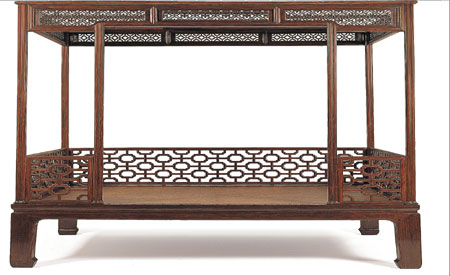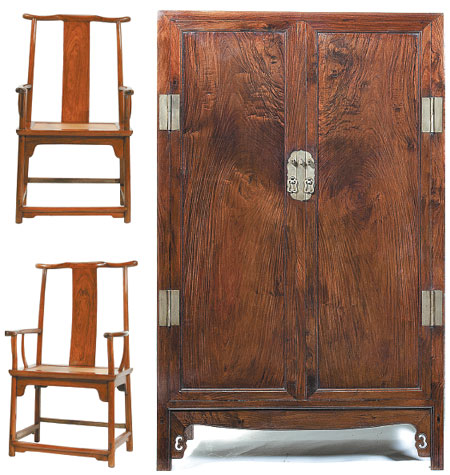Ming furniture exhibition opens in Beijing
Updated: 2014-04-04 07:16
By Lin Qi (China Daily)
|
||||||||
Simple elegance is the hallmark of Ming-style furniture, and a new exhibition in Beijing offers a rare chance to see this ancient craftsmanship, Lin Qi reports.
The late scholar Wang Shixiang (1914-2009) visited a Ming-style furniture exhibition in Hong Kong in 1994. He wrote a poem to express his impression:
"A choice collection, sublime and divine. But a momentary parting, what accomplishment before my eyes."
The exhibition was mounted by Wang's friend Grace Wu, a collector of Ming-style furniture, at the Grace Wu Bruce gallery that she opened in 1987. The space specializes in dealing Chinese furniture of the 16th and 17th centuries, and was given its Chinese name, "jia mu tang", literally meaning the hall of refined wood, by Wang, an acclaimed connoisseur of antique furniture.
To commemorate the centennial of Wang's birth, Wu has assembled 50 sets of Ming-style furniture for display at the Today Art Museum. She chose the first two verses of Wang's poem as the theme.
The display is part of an exhibition titled Perfection of Life held by China Guardian Auctions. It juxtaposes the centuries-old wooden furniture with 20 oil paintings by leading contemporary artists, such as Xu Lei, Ji Dachun and Jia Aili.
"It can't be more appropriate to pair the Ming-style furniture with these paintings. The furniture's refined glow and the paintings' vibrant colors coexist in harmony," says Qiao Hao, head of Guardian's furniture department.
Wang, a founder of the study of Ming-style furniture, wrote several books about his research of classic Chinese furniture carpentry and design. His definition of the Ming-style furniture refers to those made of valuable wood during the late Ming (1368-1644) and early Qing (1644-1911) dynasties.
"The furniture was not massively produced but made to order for an individual. Scholars were fully involved in the design process and the furniture pieces differ from one another in measures and details," Qiao says.
A Ming-period sloping-stile and wood-hinged cabinet on show represents ingenious design and excellent woodwork.
The four legs slope slightly outward to give the cabinet an "A" shape - and a sense of balance and stability. The cabinet is elevated off the ground to keep the books inside away from humidity.
More details in design enliven it with touches of elegance. The copper door handles look like jade droppings, and together with the inlaid metal plates which they are attached to and the lock receptacles, they demonstrate the exquisite handicraft of that time.
Most surviving Ming-style furniture was made of the huanghuali wood, which belongs to the rosewood family. The tree grows slowly. Its wood is strong and heavy, featuring a surface of natural polish and refined colors. It presents distinctive levels and vivid, smooth textures after being waxed.
A pair of huanghuali high yoke-back armchairs are exuberant with the majesty and dignity of the Ming-style furniture. They are also called "guan mao (officials' hats)" chairs, as the headrests with their stretched-out ends look like a Ming Dynasty court official's hat.
The chairs' C-curve plain back splat exemplifies the extravagance of producing Ming-style furniture: A curving splat was carved from a whole piece of wood and it consumed only about 30 percent of the raw material.
"Western furniture has evolved from complexity to simplicity in design. Chinese furniture, however, developed in an opposite direction. It reached the pinnacle in the Ming Dynasty, marked by simple lines. But it went more and more sophisticated in the Qing Dynasty, influenced by the intricate Western design," Qiao says.
Wu had her first encounter with Ming-style furniture at the Victoria and Albert Museum when she studied in Britain some three decades ago.
"I was enthralled by the furniture's perfect appearance and had a strong desire to own them. At first, I bought them for home decoration. Then I came to realize they are so rare and valuable," she says.
Wu first met Wang in the early 1980s. Wang showed her the draft of Classic Chinese Furniture - Ming and Early Qing Dynasties, in which he used detailed illustrations to explain the furniture's mortise-and-tenon joints.
The book, well received as a masterpiece of Ming-style furniture appreciation, was published by the Hong Kong-based Joint Publishing in 1985 and then translated into other languages.
"It (the book) helped leverage my understanding of the furniture to a higher level - one should not only appreciate the aesthetics of Ming-style furniture but also study its mythical structures," Wu says.
When Wu started to collect Ming-style furniture, it was known by very few people, even those in the country from which it originated. Today, it has become sought-after at auctions with prices surging year by year.
Qiao says it is almost impossible to collect all forms of Ming-style furniture, because few pieces are available on the market and they are too expensive. If people really want to purchase an example, he recommends a chair.
"A chair is comprised of more than 40 components, and people can appreciate it and sit on it," he says.
"The best way to preserve Ming-style furniture is to use it on daily basis. Don't treat it like an untouchable antique, mentally, I mean. The age-old furniture being protected in a glass case does not have the same glow as a piece that has close contact with its owners."
If you go
10 am-6 pm, until April 11. Today Art Museum, 32 Baiziwan Lu (Road), Chaoyang district, Beijing.
010-5876-0600 Ext 100.


|
Perfection of Life displays some of the country's finest antique furniture, including a huanghuali canopy bed (top),a pair of huanghuali high yoke-back armchairs and a corner cabinet. Photos provided to China Daily |

 Gorgeous Liu Tao poses for COSMO magazine
Gorgeous Liu Tao poses for COSMO magazine
 Post-baby Duchess
Post-baby Duchess
 Victoria Beckham S/S 2014 presented during NYFW
Victoria Beckham S/S 2014 presented during NYFW
 'Despicable' minions upset Depp's 'Lone Ranger' at box office
'Despicable' minions upset Depp's 'Lone Ranger' at box office
 'Taken 2' grabs movie box office crown
'Taken 2' grabs movie box office crown
 Rihanna's 'Diamonds' tops UK pop chart
Rihanna's 'Diamonds' tops UK pop chart
 Fans get look at vintage Rolling Stones
Fans get look at vintage Rolling Stones
 Celebrities attend Power of Women event
Celebrities attend Power of Women event
Most Viewed
Editor's Picks

|

|

|

|

|

|
Today's Top News
Earthquakes cause plenty of jitters
DC film festival gets geared up
Calif. teen gets top science award
EWB toasts Houston merger
Two Chinese are winners in Met auditions
Preparation pays off in quake aftermath
Shooting reported at US Army base in Texas
Asiana admits pilot error in crash
US Weekly

|

|









